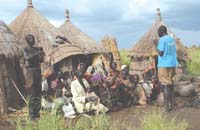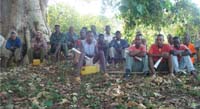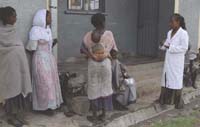Use 'Print preview' to check the number of pages and printer settings.
Print functionality varies between browsers.
Printable page generated Thursday, 22 January 2026, 1:50 AM
Health Education, Advocacy and Community Mobilisation Module: 20. Community Conversation
Study Session 20 Community Conversation
Introduction
Community dialogue, or community conversation, will help you to achieve reliable and sustainable community cooperation and action.
In this study session, you will learn about what community conversation is and you will also learn some of the methods of conducting community conversation (Figure 20.1).
Your roles in this type of work will also be explored.

Learning Outcomes for Study Session 20
When you have studied this session, you should be able to:
20.1 Define and use correctly all of the key words printed in bold. (SAQ 20.1)
20.2 Describe how to organise a community conversation. (SAQs 20.1 and 20.2)
20.3 Describe what the different roles of the facilitator are. (SAQ 20.3)
20.1 Community conversation
Community conversation (CC) is an interactive process which brings together members of the community, village or kebele and encourages them to think, discuss and explore the main causes and underlying issues behind their health problems. Community conversation is based on the recognition that people have the knowledge, capability and resources that can bring about positive health outcomes individually and collectively, once the community perceives ownership of a health problem. A community conversation is generally a good starting point for your work in the community if you want to bring about a sense of cohesion and togetherness.
One of the main tools of community mobilisation is community conversation. It gives a chance for community members to listen to each other attentively, and speak out with regard to what they think is best. It also helps all the people taking part to feel included in the process of decision making about health issues. The community members taking part in the group discussion process feel empowered, and they should become able to revise their values and consider their cultural and traditional practices.
The process of community conversation gives community members ownership of their problems, which in turn makes them able to think and find solutions for the significant health issues in their community (Figure 20.2). The general objective of community conversation is to make the community take the initiative to identify, discuss and solve the major health problems using local resources.

Community conversation helps to create an environment which is conducive for governmental and non-governmental organisations to work in an integrated way. It also helps to minimise discrepancies between community members, and to confront any negative attitudes among community members.
Box 20.1 summarises the key principles.
Box 20.1 Key principles of community conversations
- Respecting the values, beliefs, culture and traditions of the community.
- Giving particular attention to gender issues, in order to increase women’s participation and empower women.
- Create smooth relations.
- Respecting differences, building trust and solving conflicts, as well as clarifying misconceptions.
- Helping the community to accept that it has a potency to identify issues which need to be resolved, and the capacity to find solutions.
- Enabling members to take ownership of their own health.
Your friend Abeba, who is working in the nearby town of Debre Zeit, wrote to you asking what community conversation (CC) was, and what its advantages are. How would you reply to her?
You would explain to her that CC means community conversation. It is an interactive process which brings members of the community together, and engages them to discuss and explore the causes of their health problems. You might also mention that CCs are intended to be respectful of differences, and that they pay particular attention to enabling women to be heard.
20.2 Organising community conversations
In this section, we are going to look at the steps which you should follow when organising a community conversation.
Step 1
Good relationships with senior members of your community will help you to conduct effective community conversations. This will also help the facilitator and the community members to get to know each other and strengthen their relationship. This leads them to feel at ease and able to set out their views and opinions, and will help them to trust and understand each other.
Step 2
Identify the main health problems in the community. At this stage the role of the health worker is to ask strategic questions to help community members identify the main health problems or issues. Remember that as a facilitator of the conversation you should not impose your views or tell them that, ‘your problem is ……’, as this will prevent the community being able to identify their health issues for themselves.
Step 3
During this step, the community will assess and discuss the root causes of the identified health issues (Figure 20.3).

Step 4
Identify and collect together any available resources. This step helps the community to identify resources which will be necessary to help solve the identified health problems.
Step 5
This is decision making. During this step the community prioritises the identified issues and health problems, and starts to plan activities that should be carried out.
Step 6
This is the implementation stage. During this step the community implements what has been planned. Remember that you should include as many members of the community as possible in your health activities, even those who did not attend the community conversation. Doing this will help the community take ownership of the implementation process.
Step 7
This is the stage where you monitor the implementation of any chosen health activities, and make an effort to understand the changes that have taken place in the community. This step helps the community to monitor and evaluate the behavioural changes and the challenges faced at each step.
Now read again the steps outlined above. Clearly, there is a lot to think about. Consider a situation in your community (for example, about the high incidence of malaria) and try finding a way of asking some questions of the community that might raise the issue of malaria.
Of course there are all sorts of ways of developing this. You could begin with a very open-ended question: ‘What do people think are the big health problems in the community?’ or ‘What sorts of illnesses do people notice time and again in their community?’ There may already be a recognition and understanding of the health problem, in which case you could ask how they think the problem might be resolved.
20.2.1 Recruiting participants for community conversations
The discussions that are part of community conversations should include participants who are able to represent the entire community.
Think about a community you have some involvement with. Spend a few moments writing down the sorts of people you could invite who would represent between them the whole community.
You need to strive for a diversity of opinion, ethnicity, race and gender, and all the other features that reflect the make-up of the community.
Avoid inviting only the obvious people to the community conversation, for example, opinion leaders or health experts (Figure 20.4). Keep these people involved, but encourage all the participants to reach out and attract a larger, more representative group of the community. Try to involve community members who have more experience in life, because these people will know about the effects of community change and therefore will have a vested interest in the issues affecting the community (Box 20.2). In addition, this will bring consistency and continuity to the community conversation meetings.

Box 20.2 Diversity for the community conversation
Remember that by actively recruiting members who reflect the community’s diversity in ethnicity, culture, perspectives, gender and age, you will achieve a richer dialogue from a more representative sample.
20.2.2 Organising a community conversation
As the facilitator of the conversation meetings, you are responsible for creating a safe environment, keeping conversation on track, and managing the time that the meeting takes. You should also set group guidelines and ground rules, and state these at the start of the meeting.
Ground rules include asking participants to avoid personal attacks, and requesting that they should respect the diversity of opinions. Ask them to choose a recorder. The recorder should work closely with you to record key issues, areas of agreement and disagreement, and suggest any further questions. This way you will have a foundation for future meetings, as well as documented feedback for your community leaders or your woreda Health Office, or other organisations that need the information.
During the community conversation meetings, the main role of the facilitator is to understand differences between community members and make the discussions free flowing. As a facilitator, you should attempt to accomplish the two major tasks described next:
Task 1: Pre-conversation stage
- Introduce the general objectives of the community conversation to the influential local opinion leaders, and ask for their ideas and support.
- Collaborate with other community health workers and concerned people, and together with them identify and prepare the meeting room or conversation place.
- Select participants and collect all the materials needed for the community conversation.
Task 2: During the community conversation
- Facilitate the process of the conversation.
- Make sure that the conversation runs smoothly, and ensure the clarity of the views for each of the participants by checking out their level of understanding.
- Motivate all the participants to abide by the ground rules of the meeting that they have agreed to.
- Help them to stick to the main issues and the agenda and make sure that everybody listens to each other. Compromise may be necessary in order to resolve conflict by helping the participants arrive at a consensus through clarifying their ideas.
At many stages in the CC process your skills as a facilitator will be vital, in particular during the conversation itself, when you will be acting as a facilitator. Think for a moment about the skills that you believe are necessary for a good facilitator, and make a list. Then mark that list with the particular skills you feel you already have, and skills that you would like to practise.
Now read Box 20.3 below and compare your list with the items in the box. Also write down any ways in which you think you can improve your own skills.
Box 20.3 sums up the sorts of skills a facilitator would be expected to have. If you have identified skills that you would like to develop, you could do this by perhaps practising with other health workers, or asking a friend to observe you in a meeting and then to provide feedback to you about how you could improve. Some of these skills you can practise in everyday life too. Try being a good listener, ask for feedback from family and friends and so on.
Box 20.3 Effective facilitation
Guidelines for an effective facilitator:
- Be polite
- Share problems
- Be respectful
- Appreciate skills and knowledge
- Be a good listener
- Don’t be impatient or hot tempered
- Refrain from mentioning religious or political differences or other sensitive issues, such as race
- Do not take sides on an issue.
After the community conversation
Share your results and feedback with local decision makers, such as the woreda health manager, administrator, or with the kebele health committee. Your ideas will help create a better experience for all participants. Also try to be inclusive when recruiting participants, and aim to be in tune with the various groups to ensure diversity.
Summary of Study Session 20
In Study Session 20, you have learned that:
- Community conversation helps to make the community take initiatives to identify, discuss and work towards solving the major health problems using local resources.
- Community conversation is based on the recognition that people have knowledge, expertise, capabilities and resources to transform both individually and collectively their environment, once the community takes ownership of a health problem.
- Some of the key principles of community conversations include respecting the values, beliefs, culture and traditions of the community. Also, it is important to remain gender sensitive and give particular attention to women’s participation and empowerment.
- Community conversations can also help by creating smooth relations, respecting differences, building trustworthiness and conflict resolution, as well as clarifying health issues in your community.
Self-Assessment Questions (SAQs) for Study Session 20
Now that you have completed this study session, you can assess how well you have achieved its Learning Outcomes by answering these questions. Write your answers in your Study Diary and discuss them with your Tutor at the next Study Support Meeting. You can check your answers with the Notes on the Self-Assessment Questions at the end of this Module.
SAQ20.1 (tests Learning Outcomes 20.1 and 20.2)
Choose from the following list those features that you think describe a community conversation, and say why:
- CC focuses only on a very specific part of the community.
- CC works because it ignores diversity and focuses on a pre-determined problem.
- CC recognises the voices of women.
- CC takes place recognising diversity as a useful feature of its participants.
- CC does not recognise difference, as it is thought this gets in the way of proper discussion.
- A CC recognises the potency of a community talking about its problems
Answer
Items 3, 4 and 6 are components of effective community conversations. Diversity, and hearing many voices, as well as recognising the potency of a well-represented community all talking about and owning their health issues, are all a part of community conversations.
SAQ 20.2 (tests Learning Outcome 20.2)
In the following list of items, mark those which are pre-conversation work (PC), and those which are work that takes place during the community conversation (CC).
- Motivate the participants to abide by the ground rules of the meeting that they have agreed on.
- Collaborate with other community health workers and concerned people, and together with them identify and prepare the meeting or conversation place.
- Make sure that the conversation runs smoothly, and ensure the clarity of the views for each of the participants by checking out their level of understanding.
- Select participants and collect all the materials needed for the community conversation.
- Help participants stick to the main issues and the agenda, and make sure that everybody listens to each other. Compromise may be necessary in order to resolve conflict by helping the participants arrive at a consensus through clarifying their ideas.
- Facilitate the process of the community conversation.
- Introduce the general objectives of the community conversation to the influential local opinion leaders,and ask for their ideas and support.
Answer
Items 2, 4 and 7 involve pre-conversation (PC) work. Items 1, 3, 5 and 6 involve work that takes place during the community conversation (CC).
SAQ 20.3 (tests Learning Outcome 20.3)
What are the features of a good facilitator for a community conversation?
Answer
The main role of the facilitator is to understand any differences in the ideas between community members, and make their discussions quick and easy. A good facilitator has a number of personal qualities. They are polite and respectful, not impatient or hot tempered, and definitely a good listener. They also have a strong sense of the rights of the group of people they work with. They share their problems, appreciate their skills and knowledge, and refrain from mentioning sensitive issues, which may offend people in the group. They do not take sides on an issue.